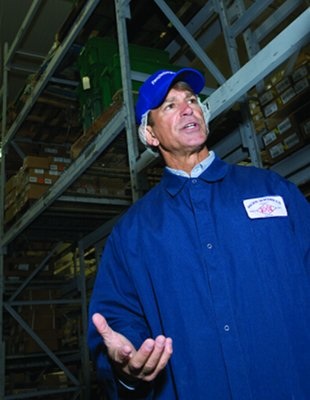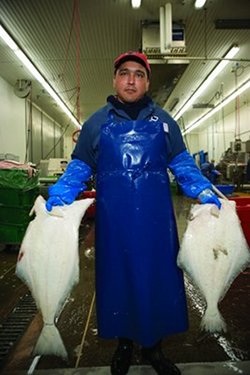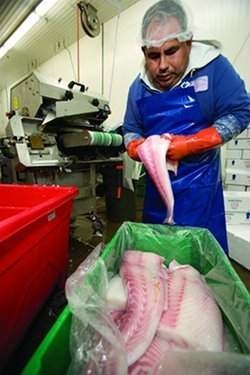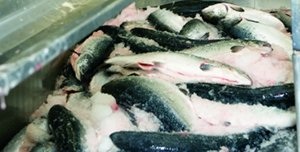 The future of the seafood industry rests with leaders such as Pacific Seafood’s Frank Dulcich, and his ability to balance strong-willed business tactics with collaboration.
The future of the seafood industry rests with leaders such as Pacific Seafood’s Frank Dulcich, and his ability to balance strong-willed business tactics with collaboration.
 “Our challenge is the fear merchants. All they sell is fear. No facts: The oceans are overfished or global warming.” “Our challenge is the fear merchants. All they sell is fear. No facts: The oceans are overfished or global warming.” Frank Dulcich PHOTOS BY STEPHEN FUNK |
The future of the seafood industry rests with leaders such as Pacific Seafood’s Frank Dulcich, and his ability to balance strong-willed business tactics with collaboration.
BY ABRAHAM HYATT
Frank Dulcich is traveling 330 miles per hour, 10,800 feet above northwestern Oregon, his Blackberry and earpiece silent in a cup holder by his side, his hands clasped together in his lap, and his attention on the Pacific Ocean, a gray line on the horizon. It’s a warm, early fall afternoon and the Pacific Seafood Group’s Learjet is flying from Portland to a processing plant in Warrenton. The interior of the plane feels cramped for a man as tall and energetic as Dulcich, but the president and CEO of Pacific Seafood is relaxed as he chats about the future of his industry and conflicts between seafood processors and conservation groups.
“Our challenge is the fear merchants,” he says. “All they sell is fear, no facts: the oceans are over fished or global warming.”
As he talks, Dulcich’s words are tempered by his outwardly charming personality, prom-king good looks and genial disposition. But his apparent warmth belies an aggressive, no-holds-barred personality. He approaches issues such as collaboration with conservation groups in an inflexible, you’re-either-with-us-or-against-us attitude.
“I won’t work with them,” he says several weeks later when talking about groups with which he disagrees. “It’s not gray. My world is black and white.”
That hard-edged personality has been the driving force behind a string of acquisitions that grew Pacific Seafood from a tiny Portland company to one of the largest seafood companies in North America.
Along the way, the 52-year-old Dulcich has left a string of coups, failed bids, near failures and newly created enemies in his wake. He has successfully fought off lawsuits that stemmed from those acquisitions and over the years has become a significant political force as well. He was handpicked to be one of President Bush’s “Pioneer” re-election fundraisers in 2004, and worked with former Oregon Republican senator Gordon Smith to shape industry-related regulations and to raise federal funds to solve chronic wastewater problems at one of the company’s plants. Because of the scope of his fish-buying empire, Dulcich has significant influence on the price that fishermen earn for their catch. If fishermen don’t like the price they can strike, and they have. But in the end — thanks to Pacific Seafood’s ability to distribute farmed fish in the place of wild catch and its ability to wait out price conflicts — Dulcich usually prevails.
The future of Dulcich’s industry will be different from the past he helped shape. The West Coast seafood industry is undergoing major changes, many of which began at least a decade ago: the rise of China as a fish producer; the restriction of fishing grounds in California; the growth of aquaculture, or fish farming; volatile prices; the influence of conservation groups.
Industry analysts say issues such as collaboration and sustainability will be crucial business decisions for seafood companies in the coming years. That’s not easy. The industry is a low-profile, insular collection of businesses that feel like they’ve been under attack by outsiders for decades; collaboration with outside groups has never been a strength. But whether they work well with outsiders or not, an industry’s largest company can and will influence the decisions of many smaller businesses beneath it, and Pacific Seafood is no different. Which makes Dulcich the leader — a leader who with his charm and hard-line business practices will have to decide how to balance the facets of his personality, his business acumen and the demands on his company as he defines the future of the seafood processing and distribution industry.
AQUACULTURE: THE RISE OF THE FISH FARM • Between the 1970s and 2006, aquaculture grew from supplying 6% of the world’s fish destined for human consumption to 47%. • Worldwide consumption of fish and fishery products rose from 25 pounds per person a year during the 1970s to approximately 37 pounds per person in 2006. • In 2006 aquaculture produced 51.7 million metric tons of fish. Based on projected global consumption, the industry will have to produce 80.5 million metric tons a year by 2030, a 56% increase. |
Pacific Seafood was the largest seafood company in North America in 2005 with $874 million in sales, according to Seafood Business magazine, but has not released its revenue figures since. It’s a private company with 2,000 employees (450 in Oregon), a base of 8,500 customers, and says that it has tripled in size in the last 10 years. The company sells more than 1,800 different seafood products and exports to Asia, Europe, and the Middle East. Its acquisition of dozens of smaller companies over the past three decades has made it an economic force in coastal Oregon, Washington, California and Alaska.
That’s a far cry from Pacific Seafood’s modest roots. In 1941, Dulcich’s grandfather, Frank, and father, Dominic, opened a retail and distribution store on Southeast Powell Boulevard in Portland. Dominic is a cheerful curmudgeon who at 83 comes to work seven days a week. Frank grew up in the store, learning the fish business from the bottom up. Before his flight to Warrenton, he stopped by the store and wandered around as his father gave a tour. “This is the guy that taught me how to fillet when I was 7, right over there at that table,” Dulcich says, gesturing to a man walking out of a cooler.
The store is a throwback. Distribution orders are filled out by hand and processed by the same method they were 40 years ago. Dulcich shakes his head as he looks around at this archaic corner of his empire. It’s clear that he keeps the store open for his father. But it won’t last forever. “One day I’ll call the store and he won’t answer,” he says. “And that will be the end.”
After visiting the store, Dulcich drives his Toyota SUV to the Troutdale Airport and the company’s waiting jet for the trip to Warrenton. Dulcich fields phone calls while rattling off the company’s often-repeated rags-to-riches tale: How, in the early 1980s, high interest rates and an El Nino weather cycle had decimated fishing fleets and seafood processors and subsequently Pacific Seafood’s meager supply of fish. How the family’s two major suppliers decided to compete with Pacific Seafood as distributors, effectively eliminating the rest of the incoming fish supply. How one of the companies came to Dominic and told him he had two choices: sell the company or go out of business.
Dulcich — a one-time international karate competitor who graduated from the University of Portland with a psychology degree in the late 1970s — was not going to compromise. In 1983, when Pacific Seafood’s competitor gave its ultimatum Dulcich was general manager and convinced his father, and a bank, to purchase a decrepit processing plant in Warrenton. It was a risky move — the plant was literally falling into the water — but it gave Pacific Seafood a steady supply of fish.
Then came the next acquisition: Portland’s Pacific Fish and Oyster in 1985. The next year brought Pacific Group Transport, a trucking fleet. The subsequent 20 years have been filled with one acquisition after another — each one a piece in the West Coast’s processing and distribution network. There are now 32 processing and distribution facilitates under numerous company names stretching from Alaska to Mexico, and from Houston to Fresno, under the Pacific Seafood Group umbrella.
The company’s acquisition path has been far from smooth. A failed takeover attempt of Tillamook’s Hayes Oyster Co. in the early 1990s led to a 15-year legal battle that Pacific Seafood eventually settled for $150,000. Pacific Surimi, a Warrenton-based subsidiary, pleaded no contest in 2002 to felony charges that it had underpaid fishermen $470,000 over a two-year period. The allegations first came to light after headline-making raids by state police on two of the company’s offices.
There were also environmental problems at the Warrenton plant. The Oregon State Public Interest Research Group sued Pacific Seafood in 2002 for illegally discharging fish waste into the Skipanon River. A federal judge eventually ruled in favor of the group’s claim. It would take five years of legal proceedings involving state agencies and federal courts before the case culminated with a $186,000 fine on the part of Pacific Seafood, an agreement to reroute its discharge system and to upgrade the city of Warrenton’s wastewater plant.
Fishermen complain (often off the record) that if they don’t sell to Dulcich because the price is too low they risk being blacklisted. Even if they take their fish elsewhere, other processors are forced to pay what Dulcich does to stay competitive. The “m” word sometimes gets tossed around, as in Pacific Seafood “is becoming a monopoly in the business of fish processing and distribution,” which an assistant attorney general wrote in a memo as part of the Surimi case in 2002.
Dulcich has heard the charges many times. He brushes them off by saying that he made the same complaints about other companies when Pacific Seafood was small. Ask him what the difference between ruthless business practices and competitive business practices are and he cracks a joke: “I’ll have to look it up in a dictionary,” he says, laughing.
“We’re in a very tough industry,” he continues. “The failure rate is exceptionally high for processors and distributors and fishermen. What you have to be is strong willed.”
 Pacific Seafood’s 62,000-square-foot processing center in Clackamas opened in 2003 and is one of the company’s major distribution hubs. |
After Dulcich lands in Warrenton, he climbs into the cramped backseat of an extended-cab pickup and talks shop with the plant manager as he rides to the processing plant. Once there, Dulcich is all smiles, touring the facility, shaking hands and greeting employee after employee by name. On the production floor he clambers up wet metal stairs past wheeled containers of fish offal and shows off components of what the company describes as a groundbreaking tracking system. It monitors in real time the progress of each fish fillet, from the moment it’s sliced up at processing plant to when it arrives on grocery shelves. Every person who touched it, every inch it traveled, even the type of plastic bag and cardboard box it shipped in, is at the fingertips of the company’s IT department.
High-tech monitoring systems like Pacific Seafood’s have become a priority for the processing industry, says Steven Hedlund, associate editor of the Maine-based Seafood Business magazine. Because of food safety issues, the entire industry is looking for innovative ways to address the concerns of regulators and consumers. Over the past nine years, Hedlund has watched Pacific Seafood climb to the top of magazine’s annual ranking of the largest seafood companies. Up until 10 years ago, food conglomerates ruled the top of the list. But the industry was too volatile for them, Hedlund says. They’ve slowly disappeared. And private, often family-owed companies have taken their place — private being the operative word.
“These companies are not high profile. They’ve been accused of not being media or marketing savvy,” he says. “It’s beginning to change, but they’re still operating pretty quietly.”
That used to be true of Pacific Seafood. While they still come across as a folksy, hometown company that occasionally gets featured in Oregon newspapers, politically it’s another story. Between 2002 and 2008, the company has spent $470,000 lobbying — via the Gallatin Group — federal legislators and agencies on industry-related issues. The West Coast Seafood Processors Association, a trade group that Dulcich helped found and is now president of, spent $1.12 million on lobbying over the past four years.
Dulcich has also contributed tens of thousands of dollars of his own money to mostly Republican candidates. Pacific Seafood hasn’t been successful in every cause it’s fought for and against in Washington, D.C. But he considers it money well spent. “It’s not an investment,” he says. “It’s an educational process.”
The word “education” gets used by Dulcich frequently. The more he talks about the future, the more he talks about the risk that comes from legislators, activists, conservation groups and environmentalists spreading what he sees as misinformation. But in discussing that risk, Dulcich describes himself and his company in a passive role. Pacific Seafood, as he presents it, is not a powerful force but a victim, a company beset by forces that don’t understand the gospel of the fishing industry: its workforce, economic impact and its position in the global marketplace. As he talks it seems he’s throwing up his up his hands at the indignity of the outside world.
The reality of the situation is more complex than Dulcich makes it sound. According to Dulcich and industry observers, collaboration between conservation groups and the seafood industry on sustainability and environmental issues is mandatory and will define the future of the industry. But Pacific Seafood says it has only partnered with one such group: Ocean Trust, a Virginia-based nonprofit that’s funded by federal agencies and conservation and private industry groups. (Two other groups that Pacific Seafood says it has partnered with or plans to, the Environmental Defense Fund and the Nature Conservancy, say they have no record of working with the company.)
Dulcich says any groups the company does work with will have to see eye-to-eye on fisheries and environmental science, and they cannot “create fear of things that are not true,” such as over-fishing. Shared values, he says, is a black-and-white issue.
One group that has met Dulcich’s standards is Greenspirit, a conservation group that Dulcich says he plans to collaborate with on aquaculture projects. (Pacific Seafood recently purchased a steelhead farm in Nespelem, Wash.) Greenspirit’s founder, Patrick Moore, was one of the founding members of Greenpeace but has since become highly critical of most environmental groups. He, like Dulcich, question the reasons the scientific community says are behind global warming, and believes that activists have distorted the environmental impacts of aquaculture.
 Every step a Pacific Seafood fish takes through the processing chain is tracked, from the filet table to the box it’s packed in to the forklift that takes it to storage. |
The pickup that took Dulcich to the Warrenton plant is the same that takes him back to town’s sparse airfield. Dulcich climbs back into his plane. In the cockpit, the jet’s two pilots speak into their headsets as the sound of the engines begins to rise. Outside the fog has moved in from the ocean and the sky is turning gray.
The tour of the plant was a glimpse into both the company’s history and its plans for the future. The Warrenton plant was its first acquisition and it’s now used as a showcase for innovation. Pacific Seafood’s future growth likely will come from more acquisitions, according to Hedlund from Seafood Business. He says Pacific Seafood’s growth is likely to creep further into the central and eastern states. More distribution means the need for more products. That means looking for producers in China and the rest of Asia. And it means aquaculture.
Dulcich insists that in the coming years Pacific Seafood will remain a place where his four children can climb, like he did, from the production floor to the boardroom. Indeed it’s Dulcich and groups like the West Coast Seafood Processors Association who will set the course of the seafood industry. That course can either collide with the path conservationists and regulatory agencies are on, or all sides can find common ground. Dulcich the backslapper says there will be ways to get along. Dulcich the hard-edged martial artist appears entrenched and ready to fight. Despite his black-and-white attitude toward collaboration, the future of his company and industry won’t be so stark. And it will be up to Dulcich to determine how he wants to balance those different sides as he shapes an industry he hopes his children will one day inherit.
As the engines continue to warm up before the plane takes off for Portland, Dulcich asks the pilots to make a peculiar take off, one that Dulcich requests as a way to thrill those who haven’t flown with him before. After the jet takes off, it stays level, 50 feet off the tarmac, flying 120 miles per hour. Suddenly, the pilots yank the plane upward at a 45-degree angle and for the next few seconds, their passengers are crushed into their seats by the gravitational force.
As the jet levels off and streaks east over the rim of the North American continent the pressure decreases and Dulcich laughs with pleasure at his passenger’s reactions, at once both genial host and self-satisfied master of the forces he commands.
Have an opinion? E-mail [email protected]



